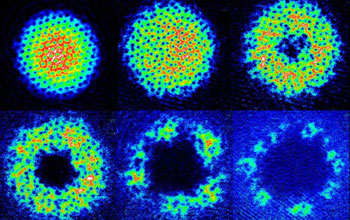Multimedia Gallery
Giant Vortex Formation
Giant Vortex Formation
This time sequence shows the formation of a large vortex aggregate (giant vortex) in a dilute gas Bose-Einstein condensate (BEC). A BEC consisting of 3 million Rb atoms at a temperature of 20 nK is spun up to rapid rotation, leading to the nucleation of a large regular lattice of vortices (first image). The vortices are visible as false-color coded density depressions within the BEC. When a small focused laser beam is sent through center of the BEC along the axis of rotation, atoms are locally removed from the condensate by the light pressure. Thus, the density in the center can gradually be decreased, inducing the vortices to assemble to a large vortex aggregate consisting of tens of vortices (third and forth image). This vortex aggregate, appearing as the dark center of the cloud, is surrounded by ring shaped superflow of atoms that still contains many vortices. In the later evolution, the ring shaped superflow fragments into small blobs (fifth and sixth image).
This work was supported in part by a grant from the National Science Foundation. (Date of Image: unknown) [One of three related images. See Next Image.]
More about this Image
This image sequence reveals intriguing vortex lattice dynamics in a dilute gas Bose-Einstein condensate. A rapidly rotating condensate forms a regular hexagonal vortex lattice, i.e., a regular array of eddies. By removing atoms from the center of the BEC, the rotation rate of the condensate can be increased. This trick, invented by Eric Cornell and his coworkers at JILA (a joint institute of the University of Colorado at Boulder and NIST, the National Institute of Standards and Technology) is based on the fact that atoms close to the axis of rotation have less angular momentum than atoms on the outside of the BEC. The laser-induced spin-up leads to shear forces in the vortex lattice. When the shear forces exceed the maximum shear strength of the vortex lattice, the lattice becomes disordered as seen in the second image. As the atom removal is continued, the central density of the BEC can be totally suppressed, and a superfluid ring of atoms remains. The center of this ring is formed by many vortices that team up to build a large vortex aggregate. Stated in terms of the underlying matter wave that govern the behavior of the condensate, the amplitude of the wave is totally suppressed in the region of the vortex aggregate, while the phase singularities associated with each vortex are preserved. Eventually the ring shaped superflow fragments into smaller blobs in which individual vortices are still visible. Vortex aggregates have dynamical stability: when the laser beam that removes atom from the center of the BEC is switched off after the formation of the aggregate, it takes several seconds until atoms fill in the center of the cloud again and a regular lattice is formed again (not shown in the image sequence).
While vortices have been detected in several other systems that are governed by a macroscopic wavefunction, this nucleation and direct imaging of a vortex aggregate demonstrates the unique opportunities that dilute gas BECs offer researchers who are studying the basic laws of nature.
Credit: Peter Engels, JILA
Images and other media in the National Science Foundation Multimedia Gallery are available for use in print and electronic material by NSF employees, members of the media, university staff, teachers and the general public. All media in the gallery are intended for personal, educational and nonprofit/non-commercial use only.
Images credited to the National Science Foundation, a federal agency, are in the public domain. The images were created by employees of the United States Government as part of their official duties or prepared by contractors as "works for hire" for NSF. You may freely use NSF-credited images and, at your discretion, credit NSF with a "Courtesy: National Science Foundation" notation.
Additional information about general usage can be found in Conditions.
Also Available:
Download the high-resolution JPG version of the image. (1 MB)
Use your mouse to right-click (Mac users may need to Ctrl-click) the link above and choose the option that will save the file or target to your computer.

